Raising Water Consciousness through
World’s Biggest Photo Exhibition and
Largest collection of Photo Stories on Water
Photo Stories | Drinking Water
Best Practices in Rural Drinking Water Management: A Case from Thar Desert
Nandita Singh and Om Prakash Singh
31 July, 2017
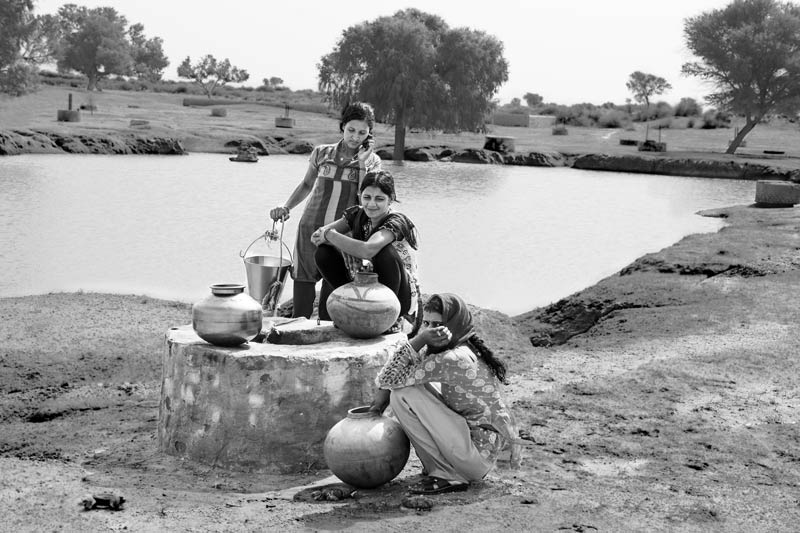
Access to safe drinking water in rural India presents multiple challenges on quantity as well as quality fronts. Groundwater, on which about 90% of rural drinking water supply depends, is getting depleted fast, besides serious quality degradation. Surface water too displays similar concerns. The rural drinking water challenges have been presented in the photo story dated 16 June 2017. Against this general problem context, the situation in the arid Thar Desert is expected to present even greater challenges. The Thar is located in northwestern India, with about 60% of its area lying in western Rajasthan, spread over mainly the districts of Barmer, Bikaner, Jaisalmer and Jodhpur. The climate here is classified as ‘hot desert’, with highest temperatures ranging between 45-51°Celsius during summers and average annual rainfall as low as 251 mm, confined mainly to the monsoon months of July to September. The soil is largely sandy and saline, stretching over the surface as vast high and low sand dunes. Further, there are extreme rainfall variations leading to frequent droughts. These arid conditions imply a situation of limited freshwater availability, further exacerbated by high salinity of the groundwater. However, despite these harsh realities, surprisingly enough, the Thar is the most densely populated desert of the world. Currently a population of about 27.5 million resides in the desert area of Rajasthan, approximating 40% of the state’s population. The rural and urban communities in the region have rich long histories and vibrant colorful cultures. Obviously this could not have become possible without adequate access to water. This photo story sets out to unravel the mystery of how drinking water has been sustainably managed in the rural communities of arid Thar Desert in Rajasthan. It describes the case of a village called Binjharwali, located in Bikaner district, Rajasthan where only 3 years in a decade receive normal rains (called accha zamana or ‘good rains’) while the remaining are low rainfall (called akaal or ‘drought’). The water table is about 60 meters deep and groundwater is saline. Despite this context, the village enjoys the luxury of accessing clean sweet drinking water throughout the year. As will be described below, the secret of their water prosperity lies in the art of rainwater harvesting through generations where every drop of the precious rain that falls on their land is collected and conserved in different ways. What is noteworthy is that Binjharwali is not an exception. It is one of the ideal examples amidst myriads others in the Thar that have been quenching their thirst and supporting the development of a rich water culture even when government and other agencies continue to reckon them as ‘water poor’. The title photo portrays the prosperity in Binjharwali where young girls chat on the mobile phone while happily collecting drinking water from a shallow well (kuin) situated within the village catchment (paitan). Sweet drinking water is available round-the-year, a dream for many even in Mausynram and Cherrapunji – the highest rainfall areas of the country.
GLOSSARY: Jharney ka pani : spring water, Johad : pond, Kuin/Kuiyan : shallow well/wells, Kund : large underground tank,
Kundi : small underground tank, NGO: non-governmental organization, Paitan : catchment, Tanda : cluster of shallow wells
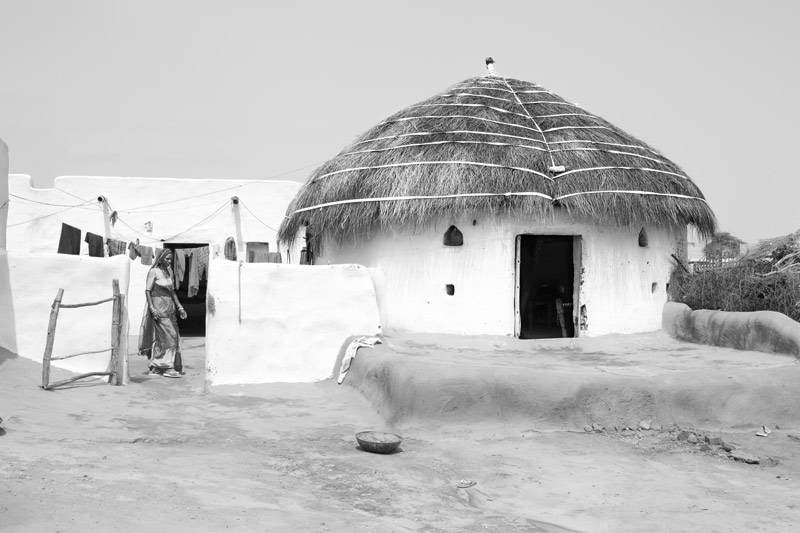
A view of the village settlement showing a traditional house made of mud-plastered walls and thatched roof which helps beat the heat of the desert
Binjharwali is a large village with a geographical spread over an area of 4,488 hectares and as per 2011 Census, inhabited by a population of 2,183 individuals with 1,151 males and 1,032 females. They are distributed in 310 households belonging to about a dozen different castes. The nearest town Lunkaransar is located about 30 km to the East while the district headquarters Bikaner is approximately 60 km away. In terms of local government, it is a part of Makdasar gram panchayat. About 2/3rd of the population identify themselves as ‘main workers’, which implies that they have employment for more than half a year. Of these, majority are cultivators (owner or co-owner) and over 45% are women. Agriculture and animal husbandry are the primary occupations in the village.
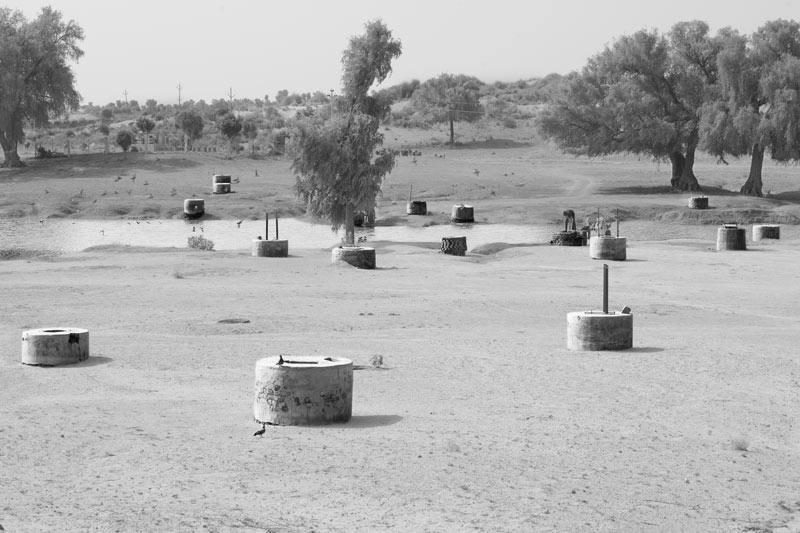
A view of the main drinking water supply site in the village comprising a large catchment (paitan), a pond (johad) and shallow wells (kuiyan)
The source of clean sweet drinking water in Binjharwali are shallow wells, locally called kuiyan, that are several centuries old. These occur in a cluster called tanda which comprises about 150 wells. The tanda is located in a catchment (locally called paitan) close to the village settlement. The area of the paitan is large, with a radius of approximately 500 meters. In middle of the catchment, in the deepest part, rainwater flowing in from all directions collects in a pond, locally called johad. The shallow sub-surface aquifer in the tanda gets recharged during the monsoon and provides drinking water in the wells filtered through natural soil layers. The water from the shallow aquifer is locally called jharney ka pani (spring water).
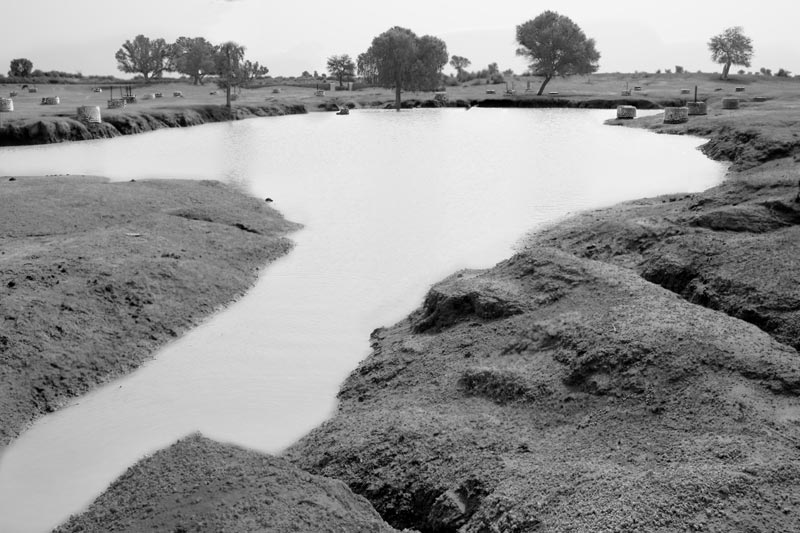
The johad in the middle of the paitan and one of its inflow channels
A number of inlets feed the johad from different directions. This johad is said to be about 400 years old, created mainly with the purpose of recharging the tanda as well as providing drinking water to the livestock as long as the water lasts. The johad water is not directly collected for human consumption since it is believed that drainage through the catchment pollutes it. Thus, the rainwater harvested in the johad is allowed to be absorbed in the soil and then filtered out through the kuiyan, a process that restores its purity, making it potable.
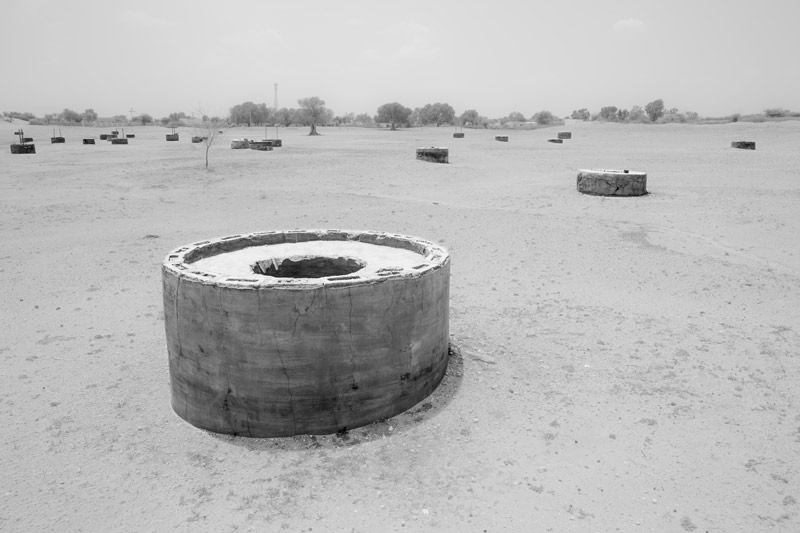
A view of the kuiyan spread over the large paitan close to the village settlement
The paitan, johad and kuiyan in Binjharwali have been community managed through generations. In recent times, the non-governmental organization (NGO) Urmul that had been long engaged in village development work in Binjharwali, has supported the community in rejuvenation, maintenance and protection of their kuiyan and johad. Urmul helped construct walls on about 50 kuiyan, making them safer to use. It also motivated the community to engage in regular management of the paitan, by cutting down the bushes and grass and cleaning up the area at least once every year. Since 2001, every year in the month of June before the onset of monsoons, cleaning of the johad and the surrounding paitan is organized by the community. At least one member from every household participates irrespective of caste and both women and men join. Youth volunteers are particularly engaged in the activity.
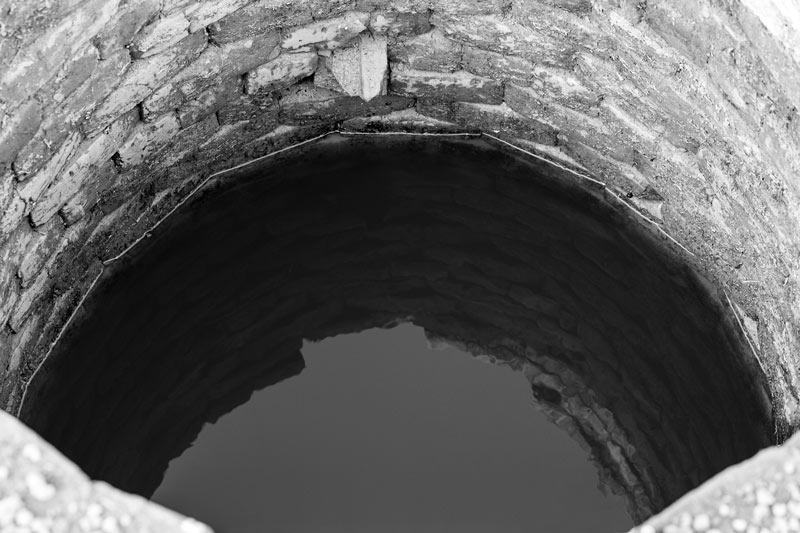
A fully recharged kuin during monsoon season
A carefully managed paitan helps conserve each and every drop of rain received during the monsoons, in turn recharging all the kuiyan every year. Social rules have been defined by the community regarding maintenance of cleanliness in the paitan and general management of the community’s water wealth. These rules are strictly followed, and defaulters may have to pay heavy fines. A recharged kuin is able to supply drinking water to the village households almost throughout the year.
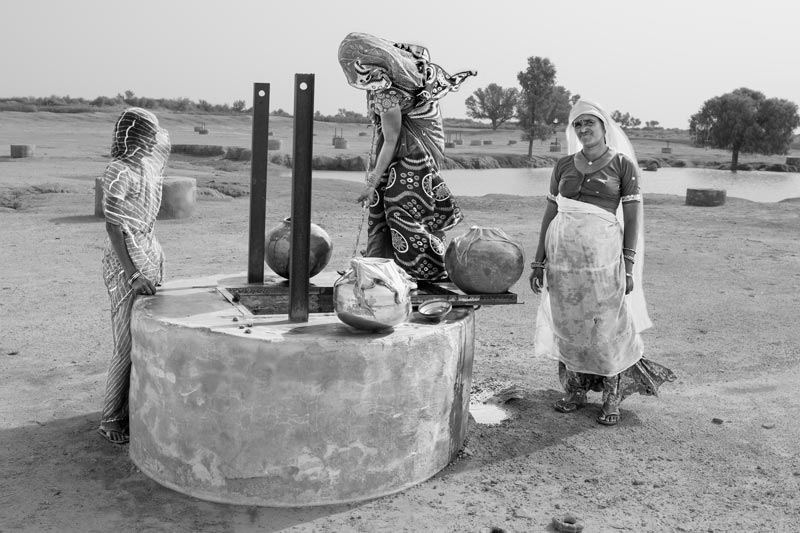
Water being drawn from a kuin for filling drinking water containers
The depth of the kuiyan varies between about 6 and 13 meters. Its base is about 2 meters in diameter while the top is narrower. Water is available at a depth of 1-1.5 meters immediately after monsoon and gradually lowers down.
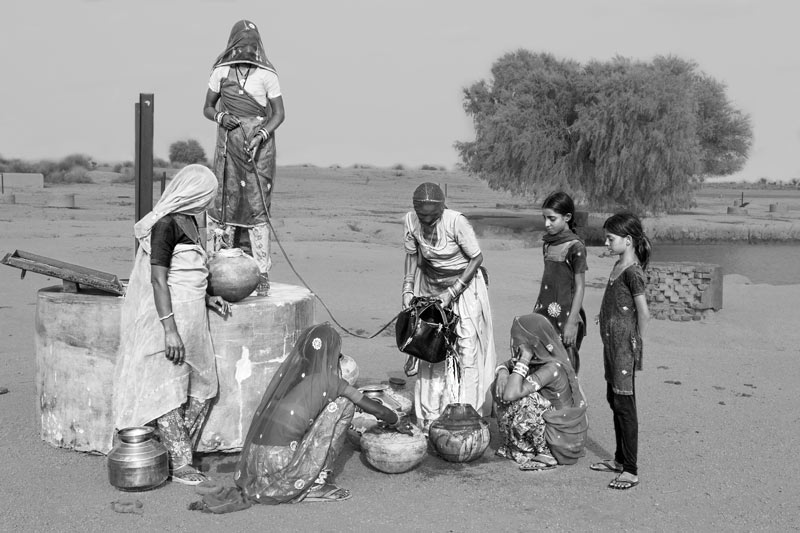
Pitchers being filled with water drawn from a kuin
Water used to be originally drawn from the kuin using a leather bag fixed to a rope, but in present times this is replaced by artificial leather or plastic bags. The kuin water is sweet and clean, but even then women take the precaution of filtering it with a fine cotton cloth while pouring into their pitchers.
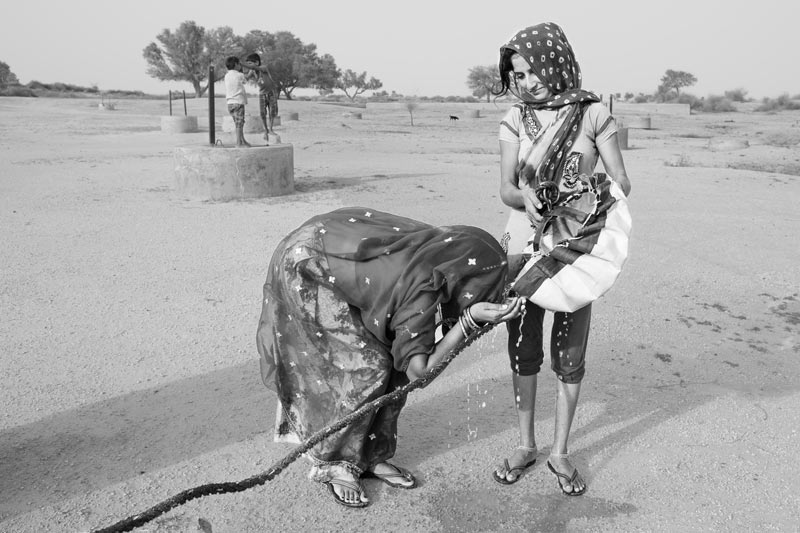
Quenching the thirst at a kuin on a sunny morning
The drinking water from kuin fulfills the aspirations of women, men and children regarding good quality drinking water. In general, the common belief is that ‘water under the ground is pure’. So, given a choice, women prefer to fetch and use drinking water from the kuiyan. Though there exists a rural water supply scheme installed in 1987 with Indira Gandhi Canal (IGC) as the source, this water is taken for drinking purposes only when the kuiyan run completely dry. The supply water is reported as unclean and impure, causing instances of vomiting, diarrhea and jaundice.
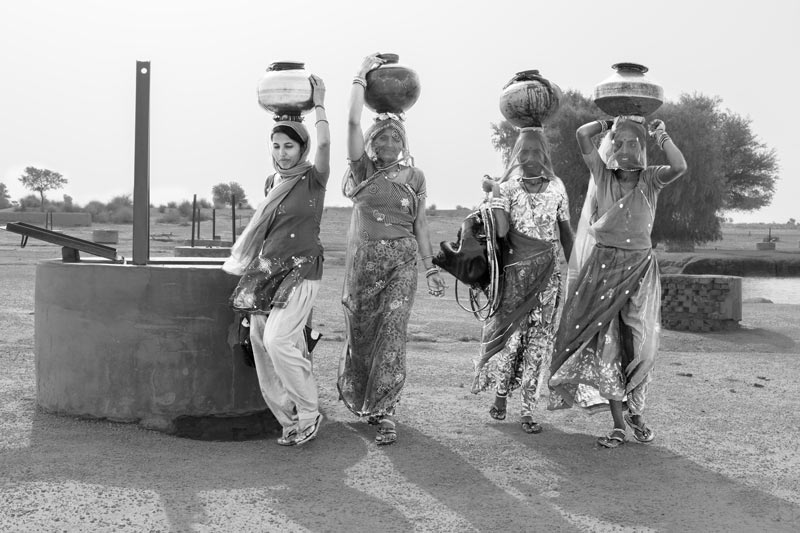
Heading home with sweet drinking water for the family from a kuin
The kuiyan supply water almost round the year. When water is plenty, women can procure water from any kuin, there being no restrictions. But during the summer months of April-June, if the preceding monsoon has been scanty, then water may begin to dry up in the kuiyan. At this time, only about 50-60 litres water may come in any kuin which is barely enough for one household. Therefore, even locks may be put up, and one may be required to fetch water only from a well earmarked for the family. In case any kuin dries up, then water may be borrowed from another one on an exchange basis. In the worst case, where most wells may dry up, then they have to buy water from external tankers or unhappily revert to using the IGC supply water if available.
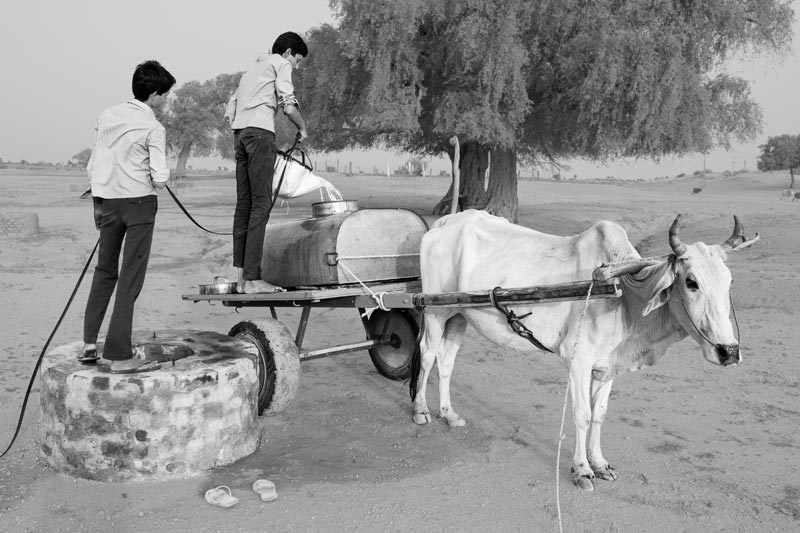
Filling a tank of sweet drinking water from a kuin to be transported home on a bullock cart
While women and girls from many families carry home the kuin water in pitchers and pots on a daily basis, boys and men also actively help in improving their access to the preferred water. They carry home drinking water in bulk from the kuin, filling in tanks of 500-1000 liters capacity loaded on bullock- or camel-drawn carts, or even jeeps. This tanker water is poured into a small underground tank (kundi') at home. Depending on the size of the home kundi, and the number of household members, these may be filled once every 2-3 days or after longer periods. Most households possess a bullock or camel cart which is used for transporting water from kuin.
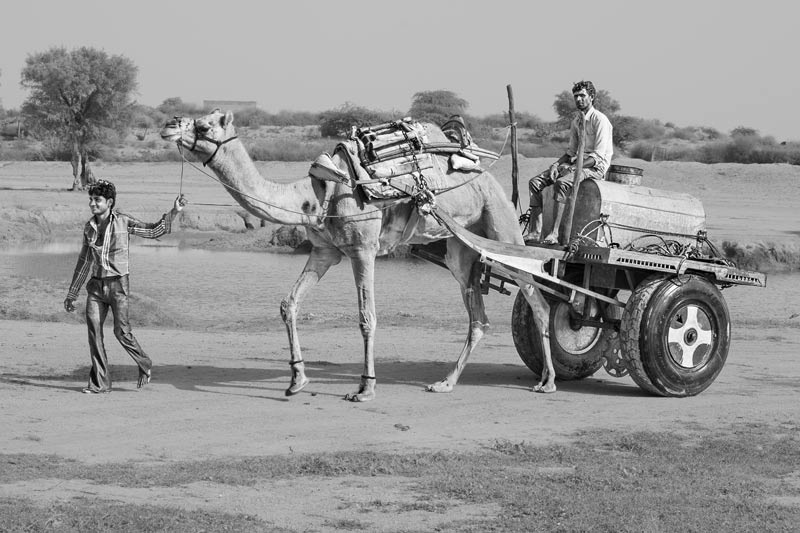
Hauling kuin water in bulk on a camel cart for home use
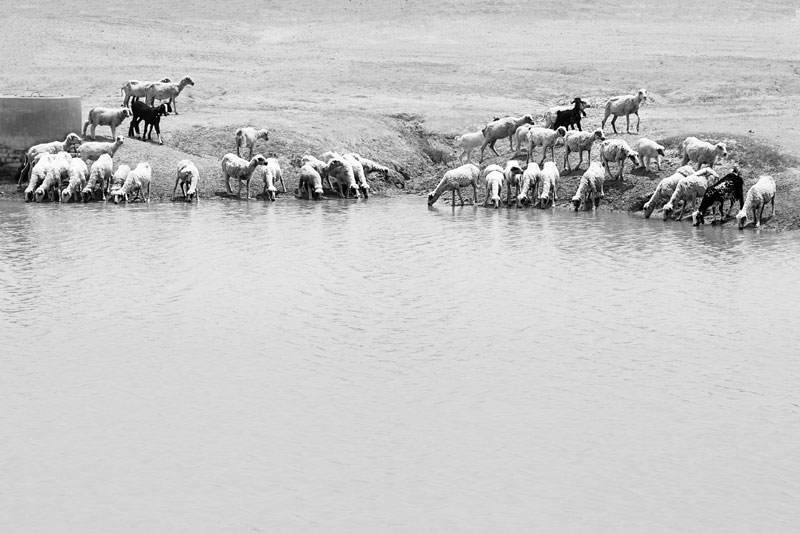
Livestock drinking water at the johad filled by monsoon showers
The johad is a good source where animals can get drinking water as long as the water lasts. Not only do cows, camels, goat and sheep from the village drink water here, but even animals from neighboring villages are allowed. As seen in the photo above, the sheep and goats drinking water have been brought by a shepherd from the neighboring Dhoodhiwali village. This shepherd possesses a rich animal wealth of about 200 sheep and 80 goats. A good number of households in Binjharwali possess large livestock.
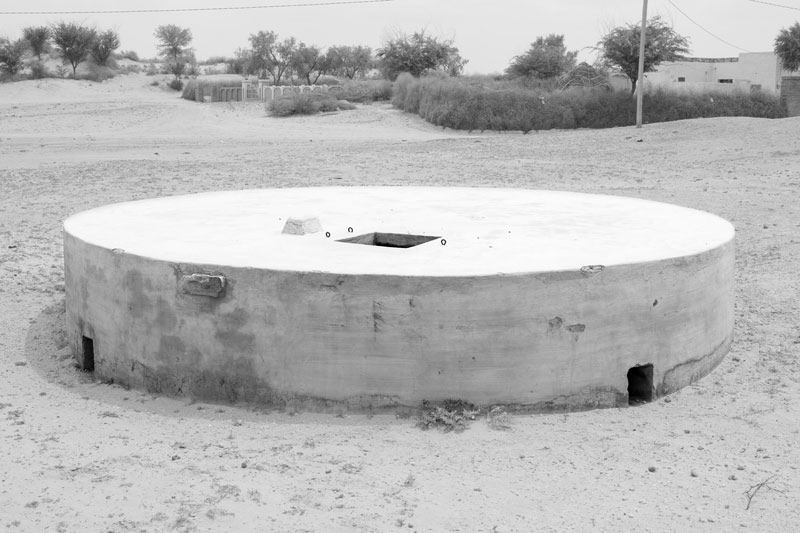
A large underground tank (kund) for storing rainwater collected from a catchment located in a communal space
A kund is a large underground tank that may be 1000 liters or more in capacity and constructed for harvesting rainwater from a large catchment that could be located in the backyard of a house or in open communal space or even in the agricultural field. Traditionally, every household had an individual kund for harvesting rainwater and storing it for the long-term lean season. Those in communal spaces are meant for public use, while those located in fields are meant to be used by farming families during the agricultural season, so that water need not be carried over from home through long distances. Meticulous care is taken before the onset of monsoons every year to clean up the catchment of the kund. Cattle grazing and entry with shoes into the catchment area is generally avoided. This bestows the benefit of cleanliness, thereby upholding the water quality and preventing water-borne diseases, rainwater being the purest form of water naturally available on surface. In recent times, kunds have been constructed in many houses and other locations with agency support, including government and NGOs. The kund shown in the photograph above is made under government’s watershed program and is meant for public use.
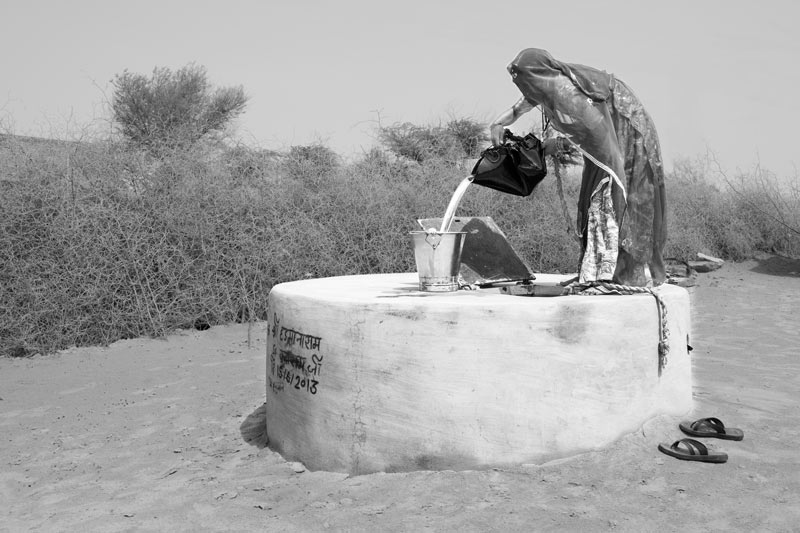
Drinking water being drawn from a small underground tank (kundi) at home
Kundi is a small underground drinking water tank often constructed in front of the house. These are mainly constructed with the aim of harvesting rainwater from a small catchment around, water being channelized either from the roof or a selected cleaned catchment area in the courtyard. The water from kundi is primarily meant for daily use and the capacities are often upto 500 liters. However, sometimes these can be upto 1000 liters or even bigger. In present times, kundis are also used as water reservoirs which are filled by transporting water in bulk from the kuin or supply water. This helps improve domestic water access and reduce the drudgery of women and girls in making multiple trips to the water source in the heat and dust of the desert. Many houses possess two kundis, one meant for storing kuin water and another one used for storing the IGC water. Storing of the IGC water additionally helps in allowing the solid impurities to settle down, making it cleaner. Like kunds, every household arranges for cleaning of the catchment of the kundi before onset of the monsoon. In recent years, a number of kundis have been constructed in the village with NGO support.
This photo story has illustrated how thirst has been quenched by the hundreds and thousands living in the water starved arid Thar Desert through generations using nature-based solutions, Binjharwali being one ideal example. The secret behind the liveliness and vitality of the village community in Binjharwali is their traditional knowledge which has enabled them to value the worth of rainwater as the source of life and wellbeing in the arid drylands. Further, the traditional science and technology has enabled them to identify an appropriate location for the village catchment (paitan) which can collect the maximum amount of the available rainfall and use it as well as preserve it in the sub-soil shallow aquifer, to be filtered clean through the soil layers and drawn from the shallow wells (kuiyan) for fulfilling drinking water needs. At individual level, smaller catchments are so constructed and maintained that the rain falling on-site can be captured fully and stored safely in underground tanks within domestic premises or near the site of use. The paitan and kuiyan are located at a short walking distance from the settlement, which reduces the burden on women and girls who are primarily responsible for domestic water management. Further, they are helped by men and boys by transporting drinking water in bulk from the kuiyan into the underground tanks (kundi) at home. The most important food for thought emerging from this case study is that if clean sweet drinking water can be made available round-the-year in the arid desert with limited rainfall and freshwater sources using rainwater harvesting in various forms, why a similar strategy cannot be adopted and promoted by government and other agencies across various regions in rural India where safe drinking water is becoming an increasing challenge due to quantitative and qualitative pressures? “Catching the rain where it falls” can be used as a major ‘mantra’ for ensuring such access to safe drinking water in not only water-stressed villages in other arid and semi-arid areas, mountains and elsewhere but also in quality-affected habitations with presence of fluoride, arsenic, iron, salinity and other contaminants in groundwater. The government and other agencies need not only support rainwater harvesting as a principle, but also promote the multiple methods and structures used for harvesting and storing rainwater in Binjharwali and similar other villages in Thar Desert. This should include massive awareness campaigns for promoting rainwater harvesting in this manner as the sustainable way forward for securing safe drinking water in the villages. In Binjharwali, government water supply scheme from the IGC has existed since 1987 but it has never been able to replace the kuiyan as the safe drinking water sources. The scheme provides a secondary domestic water source which has only replaced the deep wells from where saline water used to be drawn in the past for tasks like washing, bathing, cleaning and watering of animals. The unsafe groundwater-based sources in quality-affected areas can be similarly reserved for non-drinking purposes, while drinking water supply can be developed through rainwater-based sources since rainwater is the purest form of water that can be safely consumed. Rainwater harvesting is also a sustainable way forward in the face of exigencies caused by climate change. It is time to recognize the value of rainwater in the country, and promote its harvesting and use through methods and structures outlined above for addressing the rural drinking water challenges in the country. This would enable sustainable rural development and ensure the human rights of the rural populace to water, health, livelihoods, education and overall socio-economic wellbeing.